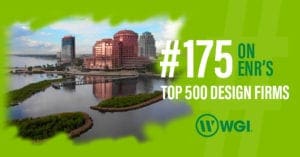
Innovation From Within: WGI’s Associates Pitch Ideas for the Future
WGI associates participated in an internal contest to pitch innovative ideas to improve the company, their work product, and the built environment.
Learn from award-winning professionals — explore our whitepapers, blogs, and the latest industry updates.
Join our dynamic organization of engineers, land surveyors, landscape architects, environmental scientists, and architects!
Talk to a market leader today! We’ll answer any questions you have about our professional services.

It’s official – the “complete streets” movement has come to South Florida, and not just to Miami and Fort Lauderdale. Municipalities throughout the region are focusing on the need to create transportation networks that do not solely prioritize the automobile. Instead, dedicated bike lanes and shaded pedestrian areas are added into the right-of-way creating safe, accessible, and walkable urban areas that are inviting to stroll — while still allowing efficient automobile movement. These “complete streets” design an environment that allows pedestrians, cyclists, and drivers to all safely use the same right-of-way at the same time with limited interactions, resulting in limited danger.
A “complete street” is defined by Smart Growth America as a street where, “everyone, regardless of age, ability, income, race, or ethnicity, ought to have safe, comfortable, and convenient access to community destinations and public places – whether walking, driving, bicycling, or taking public transportation.” (https://smartgrowthamerica.org/program/national-complete-streets-coalition/) When put in practice, complete streets create separate zones within the right-of-way; areas for pedestrians, cyclists, and (of course) automobiles. Since urban streets traditionally prioritize allotting space to both cars and pedestrians, it’s the addition of bike lanes that is the big news.
With so many diverse types of streets and street conditions, retrofitting existing roads into complete streets can take many forms. There is no one way to update a roadway to a complete street; the method and exact layout are flexible, but they do follow a general set of guidelines. In most cases, particularly in more densely populated areas, these include: reducing the width of the drive lane to slow traffic, creating a separate area for cyclists, and adding street trees to enhance the pedestrian area.

While the addition of bike lanes and street trees might seem frivolous, studies show that complete streets have many benefits:
Road safety is a key benefit of complete streets, and not just the safety of bicyclists. Studies show that adding bike lanes and street trees help to calm traffic speeds, and reduce car accident frequency. In most cases, bike lanes fall between the drive lane and sidewalk; this helps to better shelter the sidewalk from the traffic, making pedestrians safer. The sidewalks themselves are safer, and bicyclists now have their own space, no longer needing to weave between pedestrians.

Studies show that complete streets, and bike lanes in particular, are good for local economies, often increasing property values as people want to live and work in areas that are walkable. This is particularly true for millennials and active retirees.
Additionally, they can stimulate the local economy. Cyclists and pedestrians are more likely than drivers to stop and walk into stores they pass. Many cities with bike corridors, such as New York, Toronto, and San Francisco, report that the businesses along the bike corridors saw stronger retail sales than businesses in the areas that were not along the route. Because of this, bike routes are often used to spur urban revitalization efforts by helping local businesses while also attracting private investment, since businesses often want to locate in bike-friendly areas to attract young workers who prefer biking and walking to driving.

As a whole, bike lanes and complete streets create a more welcoming environment for pedestrians, bicyclists, drivers, and visitors alike. This is because they produce a more attractive urban environment — not just because of the shaded, tree-lined sidewalks, but rather as a network of complete streets and bike lanes are completed, more people choose to walk and bike, removing drivers from the road. This does two things simultaneously: first, it decreases roadway congestion and second, with fewer cars on the road, the air is cleaner and there is less ambient noise for pedestrians on the sidewalk. This translates into streets that are more attractive on which to stroll, shop, and live.
This article only touches on some of the benefits of complete streets and creating an overall bike-friendly environment. There are many others. That said, it is also important to remember that there is a myriad of different ways to create a complete street and no one prescriptive solution will work for every situation. There are resources available to make it easier to determine which design considerations are right for your street. StreetMix.net is a website that allows you to create visual aids in the form of street sections by setting the width of your right-of-way, then dragging and dropping different complete street components to see what fits. Groups such as the National Association of City Transportation Officials (NACTO) and Smart Growth America have publications and very informative websites that are also valuable resources to find industry-leading guidelines for complete street design.
Resources:

WGI is a national design and professional services firm leading in technology-based solutions for the construction of public infrastructure and real estate development. At WGI, we’re providing Tomorrow’s Infrastructure Solutions Today.

WGI associates participated in an internal contest to pitch innovative ideas to improve the company, their work product, and the built environment.

At WGI, we’ll help your community develop integrated micromobility plans and policies to capture benefits, limit risks and expand choices. From pilot project design to overall mobility planning, we can help you test, scale and incorporate innovative transportation into your community plans.

WGI moves up 12 spots on the Engineering News-Record (ENR) 2021 Top 500 Design Firms List!

On too many highways, both state and federal, there aren’t enough rest areas to serve the needs of high volume truck traffic mandated to take a break. WGI’s team is ready to change that.

WGI’s experts weighed in on the future of mobility at this year’s Florida Automated Vehicles Summit in Miami.

We’re refreshing our brand to reflect the energy, inspiration, and excitement that we feel when we come to work every day.
You’ve been searching for a place like WGI. We look forward to meeting you soon.
Sign up to receive emails to hear our latest news and achievements in our monthly newsletter.
Enter your zip code, and we’ll personalize your experience with local projects, office locations, team members, and more.
WGI supports its associates with meaningful opportunities for growth, strong benefits and perks, while we work collaboratively with clients and co-consultants to shape and improve communities.






WGI is a dynamic organization with opportunities nationwide for engineers, land surveyors, landscape architects, environmental scientists, and architects.